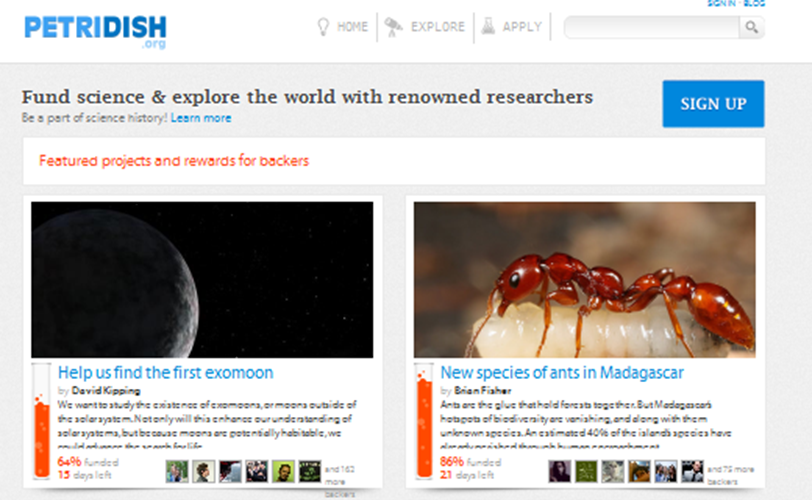Welcome, dear readers, to the most recent foray into the new, and very exciting*, world of crowdfunded science/research: Petridish.
Launched in early March, the platform’s still pretty new. Currently, though, there are 9 projects up, primarily covering critter-related projects, but not exclusively. Examples include looking into preserving the culture(s) of climate refugees, helping to find the first exomoon, and capturing (for the first time) the sounds of deep sea creatures.
Petridish vs #SciFund
Last year, there was a great deal of excitement in circles around the pilot of #SciFund, another crowdfunded science platform which ran for a limited time only, and with a limited number of projects. The first round raised $76,230, and the second is slated to begin later this year, which applications closing at the end of March.
SciFund, of course, was started and run by RocketHub, which primarily works with creative and art projects. UPDATE: One of the SciFund founders has told me that RocketHub did not, in fact, found SciFund, but rather allows the use of its platform, with SciFund having been founded by by two scientists.
Petridish, on the other hand, was founded exclusively to serve science and research - a brave tactic which them somwhat at risk, given how new science/research crowdfunding is. On the other hand, it also means tht science/research projects, and the communities which live around them, can get the proper attention they need. I wouldn’t be surprised to find out over the coming months and years that platforms such as these might work slightly differently, too.
As Matt Salzberg, former venture capitalist and now founder of Petridish, said in a conversation I had with him:
We are building a community for science and research only, which we think is necessary for crowdfunding to be successfully applied to science.
Of course, it differs from #SciFund in other ways too. Of these, some of the more obvious appear to be:
- that it’s not working on a ’round’ basis
- that its primary aim is to raise funds, and make some profit doing so. #SciFund’s (not so) secret aim, of course, is to get scientists communicating with the public. Of course RocketHub/SciFund is also a profit-making venture, too (although there has been mention made of the possibility of SciFund looking at going not-for-profit) :) So, while both profit-making currently (and nothing wrong with that), one is a side project with a ‘secret’ mission, while the other is a dedicated organisation.
- that, like Kickstartr (and its NZ equivalent, PledgMe), money is only awarded to scientists if their project raises its target funds. If not, whetever was collected goes back to the original funders.
More on that funding thang
This last difference is a major one, and one which I’ll be watching with great interest. On one hand, it makes perfect sense that, should projects not be able to raise everything, then (as is often the case with other, more artistic endeavours) they’re not doable, or not to the appropriate quality. Then again…Well, yes. We shall have to see which model turns out to be the better.
And, which makes sense, there is a limit to what funding projects can seek. According to the website’s ‘project inquiry‘ page:
We’re currently only accepting projects that require less than $15,000 in funding from our site. It’s okay if your project relies on other sources of funding as well, but the project must be sufficiently funded to be launched with funding from our site.
Of course, though, the issue of how much researchers get is moot if no one’s interested in being on the platform. So, on to the next topic.
Interest: lots or not?
Turns out, says Matt, that they’ve had “literally had hundreds of people reach out to us with project proposals. At the moment, we’re trying to keep the number of projects on the site manageable however, so are curating the best ones to some extent.” Pretty good news, I think, and it’s also encouraging to hear that they’re doing some curation around what goes up, and what doesn’t (more on that later).
Petridish launched with the projects that are there at present, but Matt says they’re hoping to add more soon, given the enormous interest they’ve seen by prospective fundees.
I also asked him why, at least so far, so many of the projects were related to biology/critters. Don’t get me wrong - with a background in molecular biology I’m far from life-hating, but I was nonetheless curious. Matt’s response?
Part of the reason we have a lot of animal, ecology and biology projects is that these are very underfunded areas of science that the public is excited about. We’re going to be adding new projects in medicine, social science, archeology and more very soon and hope to cater to all areas of study.
That seems reasonable. If nothing else, it’s going to be fascinating to track which kinds of projects raise what kind mof money, interest and so forth. And I reckon, given how cool the incentives can be - authorship rights to published papers, never-before-seen sounds or pictures, souvenirs from unusual places, talks/dinners with famous researchers, naming rights for new species, hell, even getting to _help_ with field research - that interest from funders should be high. If nothing else, the fact that some of the projects are already mostly funded is a good sign!
<mini rant>This, of course, notwithstanding the interest that people should have in (and support for) research full stop, whether they’re getting direct benefits or not, or know whether or not the research is, for example, commercially viable!</mini rant>
Getting your project onto the platform
And here’s the rub, of course. You have some research you’d like some dollar dollar bills for. Yo. But how to go about getting your project up onto Petridish. What are they looking for?
Well, the website’s project inquiry page gives you a good idea of what you need to think about. And the form to fill out’s nice and short. Also, and thank again to Matt for answering my questions:
Fundamentally, the beauty of our model is that we let the public decide which projects they want to fund. But, we do have an application process and we look for a few things:
- The quality and affiliations of the researcher or organization
- The meaningfulness of the science
- Projects that are accessible to the layperson and that we think the public will be excited about
- We make sure there is no obvious junk science like perpetual motion machines
So there you have it. Something veeery interesting to watch, or even, if you possibly can, to support! After all, you know it’s the right thing to do :)
Oh, and also? Excellent, _excellent_ name.
And, perhaps, because the following image and caption may be appropriate, and because I absolutely adore the brilliant tumblr ANIMALS TALKING IN ALL CAPS, I leave you with this, final thought (well, except for related posts and asterisks**):

LOUIS, WAIT! WHAT ARE ALL THOSE WIRES? WHAT ARE THOSE PODS?
OH, WHY DIDN’T I LOOK INSIDE THE LABORATORY SOONER?
LOUIS, WHAT’S HAPPENING?
LOUIS! COME BACK HERE! YOU’VE GONE MAD WITH SCIENCE!
—-
Related posts: Crowdsourcing science funding
—-
*And entirely necessary, given the increasing squeeze on science funding, from all fronts
** NOT ASTERIXES, PEOPLE. ARG! ASTERIX WAS ONE OF THE MAIN CHARACTERS IN THE RIDUCLOUSLY AWESOME, ORIGINALLY FRENCH, COMIC BOOK SERIES ASTERIX AND OBELIX!
